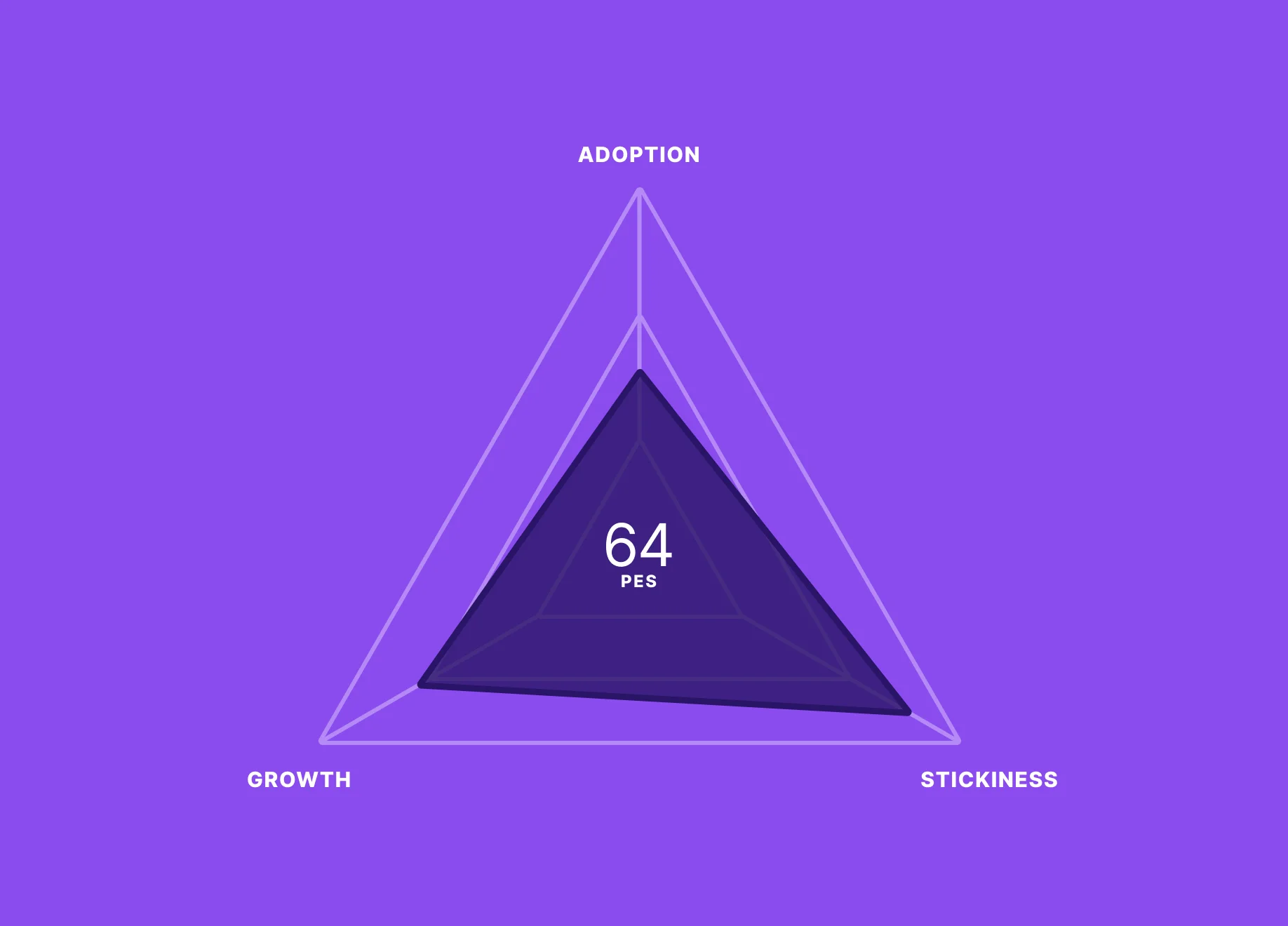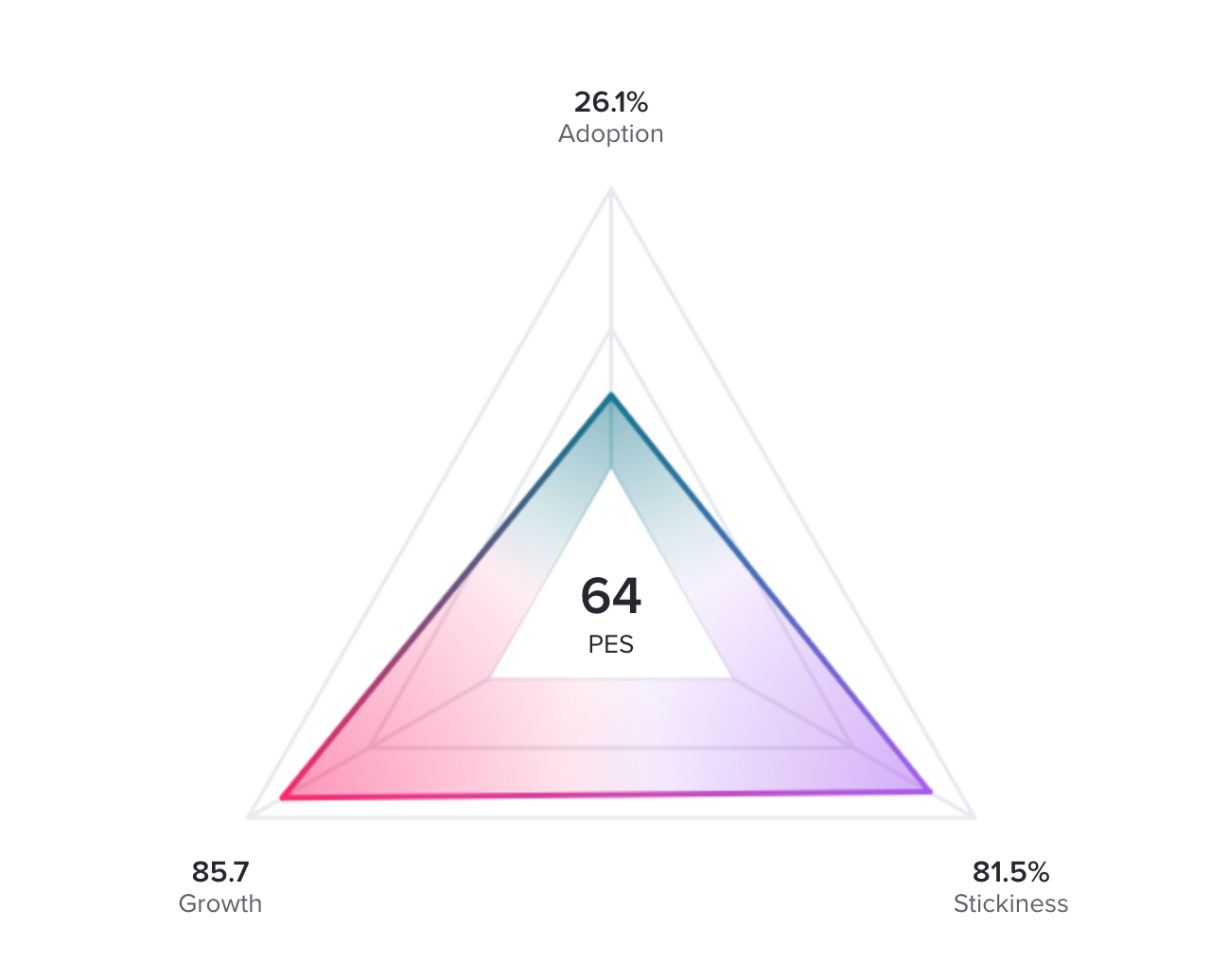Inhaltsverzeichnis
Was ist der Product Engagement Score?
The product engagement score (PES) is a metric that provides a singular view into how users are interacting with your product. It is a composite score, made up of three elements:
- Adoption: The average number of Core Events adopted across all active Visitors or Accounts
- Stickiness: Der Durchschnitt der wöchentlichen aktiven Nutzer, die täglich (DAU/WAU) zurückkehren, oder der Prozentsatz der monatlich aktiven Benutzer, die täglich (DAU/MAU) oder wöchentlich (WAU/MAU) zurückkehren
- Growth: The sum of new and recovered Accounts or Visitors divided by dropped Accounts or Visitors (also known as the Quick Ratio)
Since there are so many different product metrics (and ways to calculate them), measuring product engagement hasn’t historically been as straightforward as, say, measuring sentiment with NPS. The product engagement score aims to solve this challenge by giving product managers (PMs) an easy way to quickly diagnose how a product is performing.
Wie berechnet man einen Product Engagement Score?
Sobald Sie die Akzeptanz, die Stickiness und das Wachstum anhand der oben genannten Parameter berechnet haben, ist die Berechnung des PES sehr einfach. Um Ihren Product Engagement Score zu erhalten, nehmen Sie den Durchschnitt dieser drei Zahlen, mathematisch ausgedrückt als:
(Akzeptanz + Stickiness + Wachstum) / 3
Ein besserer PES kann für Ihr Unternehmen von Vorteil sein
Warum ist es wichtig, das Produkt-Engagement zu verfolgen?
Mit zunehmender Abhängigkeit von der Technologie erwarten die Anwender nahezu perfekte Erfahrungen von den Produkten, auf die sie sich in ihrem privaten und beruflichen Leben verlassen. Wenn Sie Ihren Kunden keinen Mehrwert bieten und sie nicht an Ihr Produkt binden, machen niedrige Wechselkosten es für sie einfach, das Produkt aufzugeben und eine Alternative zu finden. PMs müssen also sorgfältig verfolgen, wie sich die Kunden einbringen, und dann daran arbeiten, ihre Erfahrungen mit dem Produkt kontinuierlich zu verbessern.
While the product engagement score isn’t the only way to measure product engagement, one of its biggest benefits is that it allows you to dig into the why. If your PES is lower than usual, you can look at the three metrics individually to better understand what’s bringing down the average. When you combine this insight with customer feedback and in-app messages to guide users to the most valuable features, measuring product engagement becomes a continuous cycle of analyzing usage, iterating, and improving users’ experience over time.
Wie kann ich meinen Product Engagement Score verbessern?
Abgesehen von der offensichtlichen Idee, Ihre Akzeptanz-, Stickiness- und Wachstumskennzahlen individuell zu verbessern, gibt es auch bestimmte Möglichkeiten, Ihre PES insgesamt zu steigern. Hier sind drei Taktiken, die wir empfehlen:
1. Identify high-value features: Dig into your product data to better understand which features represent your Core Events, as well as where and when your users (and different segments of users) are interacting with them. From there, you can leverage in-app messages to guide customers to these core areas, ensuring they see the more valuable parts of your product.
2. Machen Sie Ihr Produkt zu einem Teil des Arbeitsablaufs Ihrer Benutzer: Nehmen Sie sich Zeit, um Ihre Benutzer, ihre Bedürfnisse und die Art und Weise, wie sie durch Ihre Anwendung navigieren, anhand quantitativer und qualitativer Daten kennenzulernen. Ziel ist es, eine häufigere Nutzung zu erreichen, indem Sie auf Bereiche Ihres Produkts hinweisen, die zur Lösung ihrer Probleme beitragen können, sodass Ihr Produkt für ihren Erfolg unverzichtbar wird.
3. Invest in onboarding: Onboarding is an important opportunity to ensure users get acquainted with (and see the value of) your product right away. An in-app onboarding strategy is useful in providing training and resources within the product itself, allowing you to educate users on features and functionality while they’re accessing them.
Wo kann ich mehr über Produktinteraktionen erfahren?
If you want to dig deeper into product engagement, Pendo has published a variety of resources on the topic. In this interactive quiz, answer a series of questions about your product and get a curated toolkit of resources to help optimize product engagement. To learn more about what product engagement is, why you should be measuring it, and how to do it, check out this hub of resources, articles, and webinars.
Dies könnte Sie auch interessieren

Ein Leitfaden zur Berechnung Ihres Product Engagement Score

Interpretation Ihres Produkt-Engagement-Scores: Wie sieht „gut“ aus?




